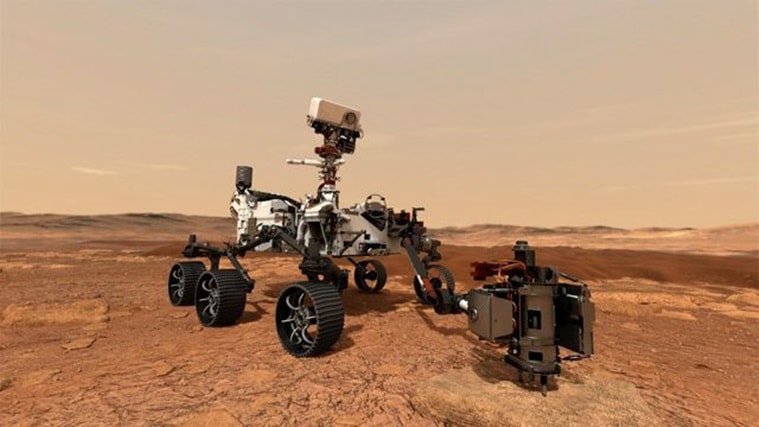Early on Friday India time, NASA’s Perseverance rover is scheduled to touch down on Mars. Last week, the UAE’s Hope mission entered Martian orbit, and was followed closely by a Chinese mission. The flotilla of missions represents the spread of planetary exploration in general, and Mars exploration in particular.
Going to Mars is non-trivial, since both planets revolve around the Sun and are hence in constant motion relative to each other. Earth and Mars are at their closest distance relative to each other every 26 months — and this is when Earthlings try to send missions to Mars.
Every two years since the 1960s, different space agencies have sent missions to Mars. Between 1976 and 1992, many launch windows remained unutilised. On occasion, there have been multiple missions in a launch window.
But never in history have three space agencies headed to Mars in a single launch window. And never in history have so many space agencies simultaneously operated a mission to Mars or the orbit of Mars. There are currently 10 spacecraft from five different space agencies — the United States, European Union, India, China, and the United Arab Emirates — either orbiting or on the ground on Mars. Two more rovers — NASA’s Perseverance and China’s Tianwen-1 — are set to land on Mars on February 18 and in May 2021 respectively.
NASA has a lander (Mars Insight), a rover (Curiosity), and three orbiters (Mars Reconnaissance Orbiter, Mars Odyssey, MAVEN); India has an orbiter (Mangalyaan-1); the EU has 2 orbiters (Mars Express and ExoMars Trace Gas Orbiter); and China and UAE will have an orbiter each (Hope and Tianwen-1 respectively).
The flotilla of missions represents the spread of planetary exploration in general, and Mars exploration in particular. This is attributable to a reduction in launch costs and the cheaper availability of the technology required in space exploration.
Dr Amitabha Ghosh is a NASA Planetary Scientist based in Washington DC. He has worked for multiple NASA Mars Missions starting with the Mars Pathfinder Mission in 1997. He served as Chair of the Science Operations Working Group for the Mars Exploration Rover Mission, and was tasked with leading tactical Rover Operations on Mars for more than 10 years. He helped analyse the first rock on Mars, which incidentally happened to be the first rock analysed from another planet.
The UAE’s mission of Hope
Two out of the three missions launched for Mars last July are already operational. The UAE, a tiny but rich country of <10 million people, bedazzled the world by becoming the fifth national space agency (after the US, EU, Russia, and India) to reach Mars when the Hope Orbiter underwent orbital insertion on February 9. The UAE beat out China in the race for Mars, albeit by a day.
The UAE mission will study the Martian atmosphere, and will seek to address the billion-dollar question of how and why Mars lost its atmosphere. The loss of the atmosphere resulted in the loss of surface water, and possibly the environment hospitable to life.
The Chinese experiment
The Chinese National Space Agency arrived at Mars with lessons learned from a successful string of Chang’e missions to the Moon. Notably, the Chang’e 4 rover was able to survive more than 25 lunar nights (each night stretches to 14 Earth days) — this is a remarkable engineering feat, since temperatures can go down to –170 degrees C. The Chang’e 5 mission was able to successfully bring back rock samples to Earth in December 2020.
Tianwen-1, the first mission to Mars from China, successfully underwent orbital insertion on February 10. Tianwen-1 carries an orbiter, a lander, and a rover. China’s approach for landing a rover is somewhat different. Unlike NASA rovers, Tianwen-1 will orbit Mars for a few months before attempting to land in May this year.
The spacecraft has a suite of instruments to address a range of scientific questions. Interestingly, it has a ground penetrating radar instrument to look for water under the Martian surface. The rover is scheduled to land at Utopia Planitia, a location with possible ancient groundwater deposits.
This week, Perseverance
The most sophisticated mission from an engineering standpoint, NASA’s Perseverance Rover, is en route to Mars, and is set to land on Thursday at Jezero Crater, which was likely filled with water in the past. Touchdown is scheduled for approximately 3.55 pm EST (2.25 am on Friday India time).
Perseverance is NASA’s 4th generation Mars Rover — starting with Sojourner from the Mars Pathfinder Mission in 1997, followed by Spirit and Opportunity from the Mars Exploration Rover Mission in 2004, and Curiosity from the Mars Science Laboratory in 2012.
The goal is to look for biosignatures in the dried up lake bed at Jezero Crater. The thought is that early life on Mars may have resembled early ocean-dwelling life on Earth, like stromatolites. If indeed this was the case, Perseverance would find fossils or some biosignatures — hints of life — in either the chemical measurements or morphological observations.
In addition, Perseverance will produce oxygen on the Martian surface for the first time, using atmospheric CO2 from the Martian atmosphere. Perseverance will cache rock samples that will be returned to Earth by a subsequent European Space Agency/NASA mission.
Musk’s Starship enterprise
The most spectacular preparation for revolutionising Mars exploration is happening away from the spotlight, in a sleepy coastal town in East Texas. This is the only effort in the mix that is not underwritten financially by government money. SpaceX, a private US-based company promoted by Elon Musk and backed by select investors, has a long-range goal of starting a commercial service to transport passengers to Mars. Boca Chica, a name that apparently no one had heard a few years ago, is now the site of development of Starship, which represents arguably the best shot at landing humans on Mars.
A human mission to Mars has been the holy grail of space exploration. Ever since Neil Armstrong landed on the Moon 50 years go, man has not been able to proceed to the next logical destination: Mars. The primary reason is the enormous price tag of a human Mars mission. In comparison to the Moon, which is only about three days away, Mars is seven months away. Carrying humans, in engineering terms, translates to maintaining a temperature controlled pressurised module. It also entails carrying supplies required by astronauts, including water and oxygen, for an approximately 18-month trip.
In addition, human missions, unlike robotic spacecraft missions, need to be returned to Earth, which in engineering terms translates into carrying an enormous amount of fuel from Earth, to be able to launch from Mars for the return journey. The engineering complexity and the increased mass requirement of a human mission to Mars, compared to the Moon, pushes costs to between $250 billion and $1 trillion. Starship promises to reduce mission costs by >95% to as much as 99% by using multiple innovations like refuelling the spacecraft in orbit, and manufacture of rocket fuel on Mars using materials that are found on Mars (and therefore, fuel for the return journey would not need to be carried from Earth).
A decade of Mars missions
As the decade starts up, multiple missions are on the drawing board: prominently, the ESA ExoMars rover mission to return rock samples from Mars, ISRO’s plans for Mangalyaan-2, and the Chinese Space Agency’s plans for Tianwen-2 that will return rock samples from Mars.
In addition, there will likely be multiple flights of SpaceX’s Starship, first with cargo and finally with astronauts. In the history of humankind, 2020 will be remembered for the Covid-19 pandemic, but the 2020s may well be the decade of a flurry of spacecraft missions to Mars, ending with the first human footsteps on Martian soil.
Source: Read Full Article



